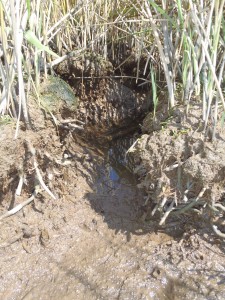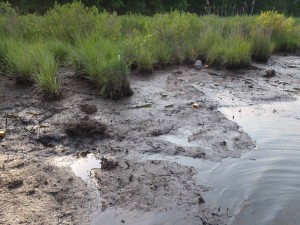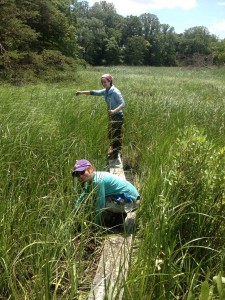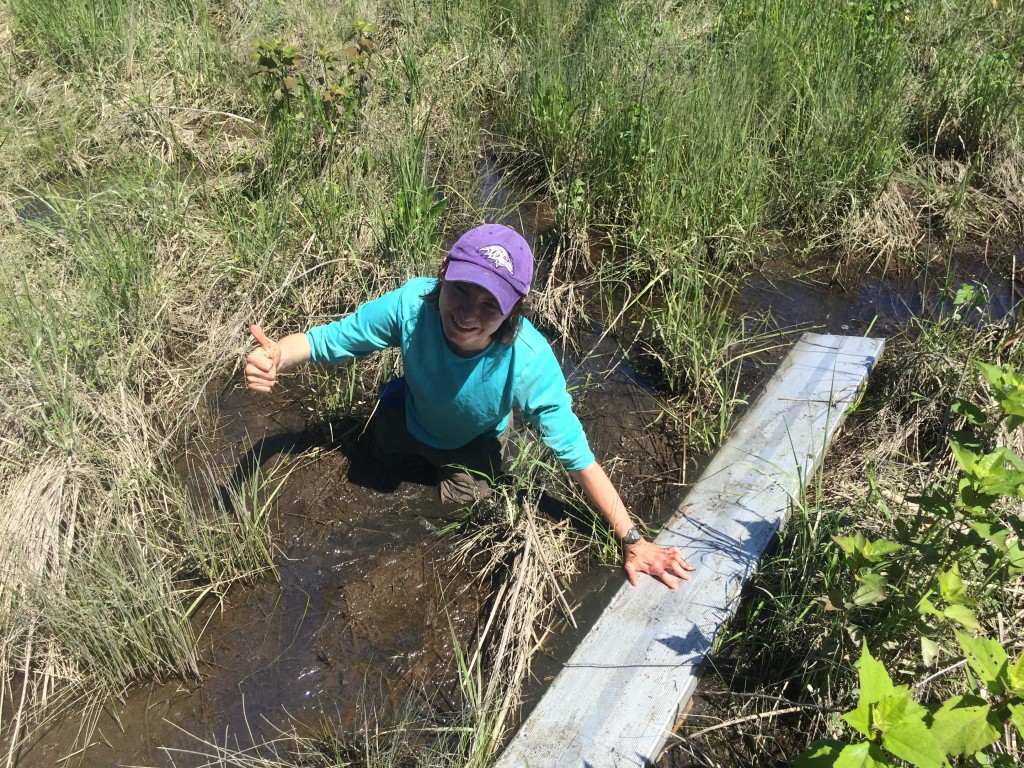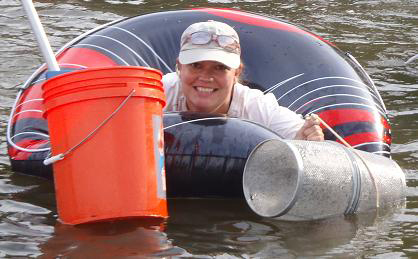by Heather Soulen,
biological technician at the Smithsonian Environmental Research Center
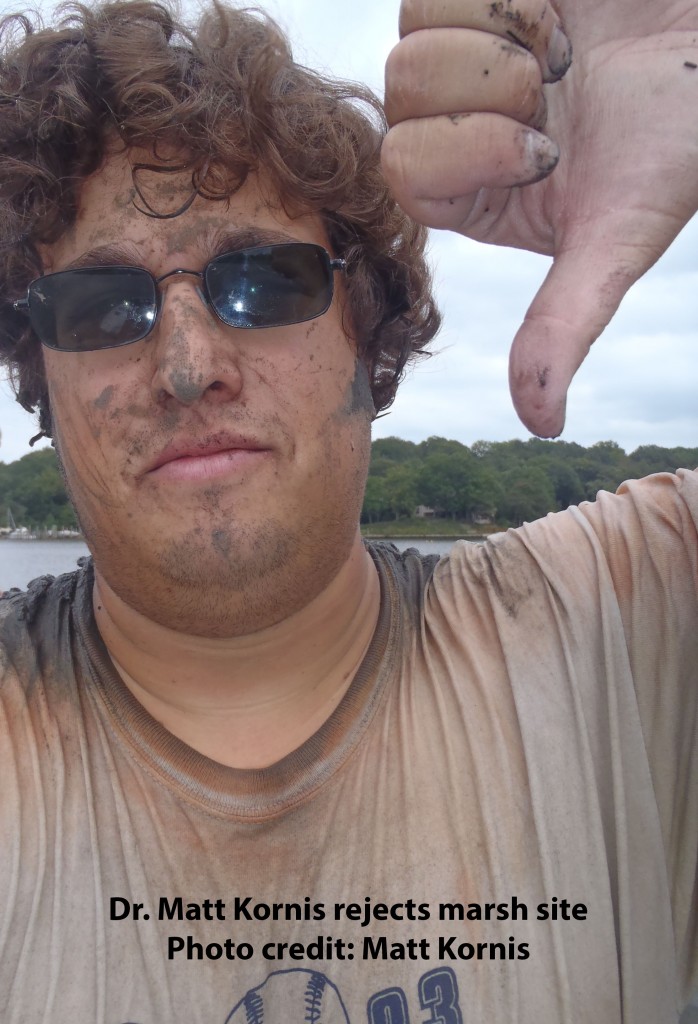
Matt Kornis, during a day navigating a marsh
Imagine if you will, you arrive at a party and proudly parade your famous 7-layer dip over to the food table and with a satisfying smile, place your gastronomic masterpiece front and center as onlookers gaze through the glass at its layered awesomeness. You hardly finish removing the lid when suddenly someone swoops in with a tortilla chip, then another person, and then another and another. You back away from the table as you begin to feel a primeval and Velociraptor-like need to eviscerate these culinary offenders. Minutes later, the ravenous horde thins and the feeding frenzy slowly dissipates. You look back at the food table and what do you see? Nothing but a grotesque slurry of beige-brown with smeared, thin trails of sour cream, salsa and guacamole. It is a pale, unrecognizable shadow of its former layered glory.
Walking around a tidal marsh can have the same effect as dragging a tortilla chip through layered dip. Walking often destroys marsh layers or the physical landscape of a marsh, creating serious problems for scientists studying the ecology and biogeochemistry of marsh systems.
Tidal Marshes are Tricksy
When doing research, scientists must consider how their presence might affect their study. Even the simple and necessary task of walking in a marsh study site could affect the study and paint an inaccurate picture of what’s going on. Feet are kind of like the tortilla chips of the marsh world: They can crush marsh vegetation, change the physical landscape and destroy the different layers (i.e. different chemical environments with unique biological communities) in marshes. Even big hobbit feet, like those of Frodo and Samwise, easily fall through the surface of the Dead Marshes as seen in The Lord of the Rings: The Two Towers.
Gollum may have expertly scrambled through the Dead Marshes, but he’d probably have a tough time in Chesapeake Bay tidal marshes because they contain other features that make walking difficult. Tidal creeks (above left), intertidal mudflats and the areas between mounds of vegetation (above right) often have layers of watery sediments that range in consistency from tomato soup to thick soft-serve ice cream. These types of sediments can easily compress and mix when walked on, even when the water is waist deep and helping with buoyancy. When the intertidal mudflats are exposed at low tide, it’s quite common to sink up to your hips or waist, which can be a little dangerous as these sediments can act like quicksand. Trying to pull your legs out, maneuver your body horizontally and belly crawl on top of the sediment feels just like slow-motion running in those chase nightmares we’ve all had. Indeed, tidal marshes are tricksy places to study, and it may make you wonder how it’s done.
How’d They Do It?
Since we don’t have hoverboards, SERC scientists have MacGyvered a couple of low-impact ways to sample marshes using everyday items. Basic stadium bleachers, planks of wood, cinder blocks and inner tubes often do the trick. Besides the low-cost, what else do they have in common? They all help distribute weight over an area much larger than the average foot.
Exhibit A: In firmer marshes, placing wide planks of wood and bleachers on top of cinder blocks helps distribute the weight of Tyler Bell, a Microbial Ecology Lab technician, as he samples pore water in a New Jersey Phragmites marsh. Exhibit B: In less firm marshes with patchy vegetation, placing planks of wood or bleachers on the surface of tidal marshes helps distribute the weight of technician Liza McFarland and intern Hope Brooks while conducting plant surveys in Chesapeake marshes for the Plant Ecology Lab. Of course, this only works if you stay on the bleacher (Exhibit C).
The Marine and Estuarine Ecology Lab faced a different kind of marsh sampling challenge. While the two labs above conducted studies in the land-plant side of marsh systems, most of our study focused on the intertidal and subtidal nearshore area of Chesapeake marshes. One factor we were particularly interested in was the nearshore slope, and how it might affect predator presence and predation. However, the soft-serve ice cream-like sediments in some areas complicated our sampling process, forcing us to find a way to reduce the impact of our foot traffic as we worked.
I don’t know how we came up with the idea, but I know we felt a kind of impish and anarchist glee in buying inner tubes to do scientific research. This $30 purchase allowed us conduct our experiments without much change to the slope – which ended up being one of the most important predictors of fish predator presence.
What Did We Learn?
While tidal marshes are beautiful, they can be challenging and dangerous places to work. (We’ll just leave my thoughts about stinging and biting insects, ticks, spiders, snakes and ROUSes for another day.) Just like dragging a tortilla chip through a delicious 7-layer dip, walking in and around tidal marshes can destroy important layers and the landscape (e.g. slope) of a marsh. As a result, SERC ecologists must MacGyver ways to cheaply and safely study these tricksy marshes with minimal impact to the study. But, between you, me and the computer screen, bleachers and inner tubes are fun, but I’d love to try a hoverboard!

